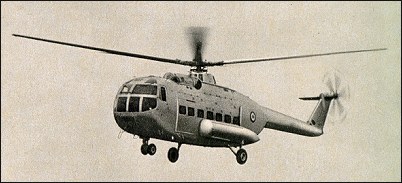
| Agusta AZ.101G 1990 |  |
 |

| Agusta AZ.101G 1990 |  |
 |
|
First flown on 19 October 1964 at Castina Costa this was Agusta's largest helicopter. Originally conceived in the late 1950s it underwent a long development phase and although almost ordered by the Italian military it never went into production and was abandoned in 1971. The A.101 had many interesting features including triple engines. The first prototype was fitted with three Rolls-Royce Bristol-Gnome H-1400 turbine engines developing 1400shp. The large airframe, with a gross weight of 12800kg and a length of sixty-six feet, had a rear ramp and twin sliding troop doors. The helicopter underwent an extensive trials period testing the triple engine system and transmission. There were several modifications to the fuselage and nose wheel during its development and in military configuration if was capable of carrying thirty-five, fully equipped troops or a 5000kg load. This large helicopter, although powered by three engines was considered under-powered. During its long development period, and still without a sales order, it was decided to extend the fuselage by almost ten feet and to fit more powerful General Electric T58 engines. Although a great improvement, the Italian Government decided not to proceed and the project was cancelled. The development knowledge obtained from the triple-engine configuration proved extremely valuable in the design and development of the latest joint UK/Italian EH-101. P.Allen "The Helicopter", 1996
The Costruzione Aeronautichc Giovanni Agusta, originally an offshoot of the celebrated Italian manufacturer of racing motor-cycles, entered the aeronautical arena in 1952, when it acquired a licence to manufacture the Bell 47G in Europe. From this beginning it has progressed to become, in terms of numerical output, the largest builder of rotary-winged aircraft in the Western world outside of the USA. Most of this output still comprises Bell types or their derivatives, but a number of native designs have also appeared. The first of these (though not the first to fly) was the A.101G. This machine was originally designated AZ.101G, the second initial denoting the responsibility of Ing. Filippo Zappata for what is still the largest helicopter yet produced in Italy. After some six to seven years' design development, including more than twelve months of ground running and tethered tests, the A.101G prototype finally made a successful maiden flight on 19 October 1964, and development was still continuing in 1968 prior to the completion of an initial batch of eight A.101G's for the Aeronautica Militare Italiano. The A.101G will be employed as a general purpose, heavy duty helicopter capable of carrying 35 passengers or a 5000kg payload in addition to the 2-man crew, or, in the casualty evacuation role, 18 stretchers and 5 medical attendants. Dual controls, autopilot and both VFR and IFR instruments are installed and there are nose and rear fuselage loading doors, all of which can, if necessary, be left open during flight enabling an extra long load to protrude at either end. The A.101G was also considered at one time for an antisubmarine role with the Marina Militare, but this service is now to have the Agusta-built Sikorsky SH-3D Sea King. Gnome H.1400's and/or General Electric T58 shaft turbines will power the production A.101G's; meanwhile the prototype flies with three 1250shp Gnome H.1200's. K.Munson "Helicopters And Other Rotorcraft Since 1907", 1968 Filippo Zappata's Agusta A.101D project was introduced at the Milan Trade Fair in April 1958, in the form of a somewhat rudimentary model. During 1959, this ambitious Italian helicopter began to take shape, but progress was slow, owing to heavy production programmes at the Cascina Costa plant. It was first flown on 19 October 1964 by top test pilot Ottorino Lancia. A lengthy development period ensued under the direction of engineers Bellavita and Lovera, involving over 400 flying hours in addition to those on the rotor test rig. The A.101's performance was inferior to that of the contemporary French Super Frelon, but it was more stable, had less vibration and a more capacious fuselage. The powerplant was new, consisting of three turbine engines. The single prototype of the Agusta helicopter underwent visible external modifications during development � it was fitted with a twin nose wheel assembly and longer fairings on each side of the fuselage, which had also been extended by grafting in a new section. The helicopter performed service trials involving rapid embarkation and disembarkation through the two lateral sliding doors and tail ramp. It could carry two pilots and 35 equipped troops, or a 5000kg load. The A.101 was examined by interested foreign parties visiting Cascina Costa and was displayed at the Turin Air Show in June 1966, where it stood out from other Agusta models simply on account of its size. By autumn 1966 the aircraft was ready for large-scale production, but a further two years were lost awaiting a decision by the authorities. In 1968 the helicopter reappeared at the Turin Air Show in camouflage finish and was tested at an all-up weight of 13500kg. At the end of autumn 1968 the A.101G was transferred to Praticadi Mare, the military airport outside Rome, for a series of trials which were completed in summer 1971. The aircraft made a few more flights, but by that time was hopelessly out-of-date. Meanwhile, Agusta had reworked the A.101H by redesigning the fuselage and a few basic dynamic components. The fuselage was extended by 3m, while the rotor remained the same, and more powerful General Electric T58 turbine engines were installed. However this programme was also cancelled in favour of production under license of foreign aircraft whose reliability had been proven, such as Sikorsky and Boeing-Vertol helicopters. G.Apostolo "The Illustrated Encyclopedia of Helicopters", 1984 * * *
|